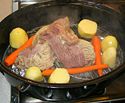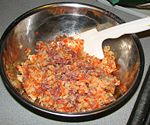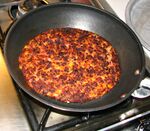Hash (cooking)
In cooking, hash is a broad term for meat dishes in which small pieces of meat are mixed with similarly-sized pieces of potatoes, spices, and other ingredients. The mixture is then fried as a single mass as opposed to being formed into smaller patties. Many connoisseurs declare that the ingredients for hash should be hand-diced or minced rather than ground. Although hash is generally considered to be nothing more than a humble and economical, though tasty, way of using leftovers from previous meals, some preparations are more elaborate and approach the standards of haute cuisine. The French chef Louis Diat, for instance, who became famous in the first half of the 20th century in the United States, created a rich, extremely savory "Chicken Hash à la Ritz" that was much in demand when he was head chef at the Ritz-Carlton in New York in the 1930s.
Most hashes are generally fried in a medium-hot, greased pan until at least part of the meat and vegetables is brown and crispy. In this case, the mixture is most commonly cooked without stirring until one side forms a pancake with an attractive brown crust. Some cooks then turn the pancake so that the other side also browns, and then serve wedges cut from the cooked mass. Some recipes call for breaking up the crust from time to time as it cooks and stirring parts of it into the main body of the hash so that it is more fully flavored. Alternatively, the hash may be cooked by broiling, or a mixture of broiling and frying. Cast iron or other pans with considerable thermal mass usually work best for this. Diat's "Chicken Hash à la Ritz" is a notable exception to the standard methods; after first cooking the diced chicken in a reduction of heavy cream, a brown crust on the gratinéed hash is achieved by first baking it and then briefly broiling the top surface.
The main ingredients are usually precooked. Corned beef and roast beef are common; turkey hash is a popular way to use up leftovers from an American holiday meal. It really is essential for potatoes to have been cooked before reducing to small pieces; raw potatoes will rarely cook thoroughly in a typical hash preparation. Finely shredded potatoes may cook through, but at least partial pre-blanching in hot water is advisable.
Other ingredients vary with the creativity of the cook. Onions and black pepper are common. A New England dish called "red flannel hash" adds chopped beets, more for color but also adding sweetness, although some cooks will use pickled beets to add a sweet-and-sour accent. Salt may be added, but, especially when an pre-salted ingredient such as corned beef is used, additional salt should be added with discretion.
Hash dishes go well with eggs—a poached or fried egg served on top of each portion of hash is common. A green vegetable, such as spinach, can be a pleasant complement to them.





